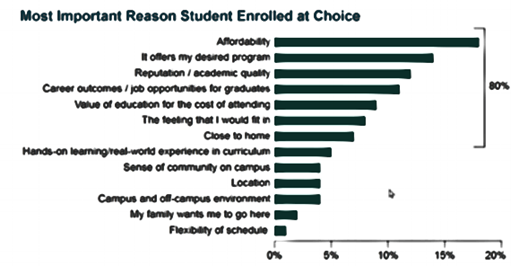As acceptance letters have been rolling in, it is nearing the deadline of May 1, when most colleges require final enrollment. Deciding where to go to college can feel like a monumental choice to many students and is one of the first big decisions most young adults make. This decision only heightened due to the uncertainty of the pandemic and the anxiety about the future. According to a study conducted by Eduventures Research surveying 100,000 American students, their decision was based at least one of the following factors: affordability, program, academic quality/reputation, value, career outcomes, proximity to home, and best fit.

According to this survey, affordability was the number one explanation for a student’s enrollment decision. By the spring of their senior year, students who filed FAFSA or the CSS Profile should receive letters from each school’s financial aid office stating how much money they will have to pay. The letters consist of grants, scholarships, and loans, and outline the direct and indirect costs of attendance. Grants and scholarships are money that does not need to be paid back, usually awarded based on merit or need. Loans do need to be paid back with interest. To calculate the money a student will pay the first year, subtract grants and scholarships from the total cost of attendance. A calculation with and without the loans can help families decide on further affordability. Create a table with each school name, the total cost of attendance, grants and scholarships, loans, and the net price to compare the prices of each school.

Examining the desired program can be important in deciding where to enroll. Research professors, courses, and what graduates end up doing (graduate school or career). Students should also look at the flexibility of changing majors because it is often difficult to gauge how academically rigorous a program is until physically there. Academic quality is essential to consider within the scope of a student’s personal learning style. Does the student thrive in smaller class sizes where participation is mandatory, or do they learn in giant lectures with exams?
When developing the college list, I help students develop a list of various criteria that are important to them in their college experience. As students grow and evolve, the list does too. I like students to revisit this list of criteria when deciding which school to attend. Certain aspects can be important in the overall academic and social experience. My criteria when choosing a college consisted of size (I wanted a small school with discussion-based courses), liberal arts (so I could study both art and science), proximity to home (I did not want to go to college in New England), strong biology program, and an undergraduate research thesis opportunity (167 pages later, I regretted this decision).
Visiting campuses and sitting in on classes is essential for the decision process. Many colleges offer virtual tours now. Check out our guide to visiting colleges for some more insight!


